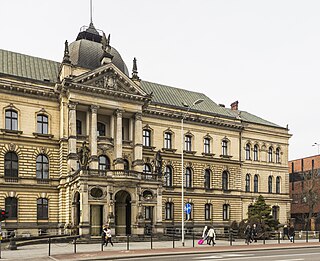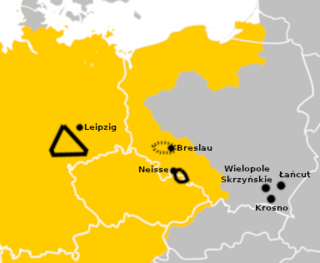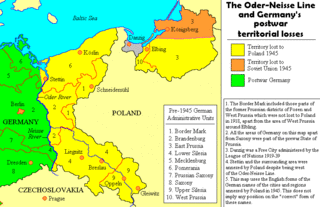
Gdańsk is a city on the Baltic coast of northern Poland, and the capital of the Pomeranian Voivodeship. With a population of 486,492, it is Poland's sixth-largest city and principal seaport. Gdańsk lies at the mouth of the Motława River and is situated at the southern edge of Gdańsk Bay, close to the city of Gdynia and resort town of Sopot; these form a metropolitan area called the Tricity (Trójmiasto), with a population of approximately 1.5 million.

Kołobrzeg is a port and spa city in the West Pomeranian Voivodeship in north-western Poland with about 47,000 inhabitants. Kołobrzeg is located on the Parsęta River on the south coast of the Baltic Sea. It is the capital of Kołobrzeg County.

Szczecin is the capital and largest city of the West Pomeranian Voivodeship in northwestern Poland. Located near the Baltic Sea and the German border, it is a major seaport and Poland's seventh-largest city. As of 31 December 2022, the population was 391,566.

Grudziądz is a city in northern Poland, with 92,552 inhabitants (2021). Located on the Vistula River, it lies within the Kuyavian-Pomeranian Voivodeship and is the fourth-largest city in its province. The Old Town of Grudziądz and 14th-century granaries were declared National Historic Monuments of Poland.

Warmian–Masurian Voivodeship is a voivodeship (province) in northeastern Poland. Its capital and largest city is Olsztyn. The voivodeship has an area of 24,192 km2 (9,341 sq mi) and in 2019 had a population of 1,425,967.

The Gleiwitz incident was a false flag attack on the radio station Sender Gleiwitz in Gleiwitz staged by Nazi Germany on the night of 31 August 1939. Along with some two dozen similar incidents, the attack was manufactured by Germany as a casus belli to justify the invasion of Poland. Prior to the invasion, Adolf Hitler gave a radio address condemning the acts and announcing German plans to attack Poland, which began the next morning. Despite the German government using the attack as a justification to go to war with Poland, the Gleiwitz assailants were not Polish but were German SS officers wearing Polish uniforms.
Silesian, Silesian German or Lower Silesian is a nearly extinct German dialect spoken in Silesia. It is part of the East Central German language area with some West Slavic and Lechitic influences. Silesian German emerged as the result of Late Medieval German migration to Silesia, which had been inhabited by Lechitic or West Slavic peoples in the Early Middle Ages.

The Kingdom of Galicia and Lodomeria, also known as Austrian Galicia or colloquially Austrian Poland, was a constituent possession of the Habsburg monarchy in the historical region of Galicia in Eastern Europe. The crownland was established in 1772. The lands were annexed from the Polish-Lithuanian Commonwealth as part of the First Partition of Poland. In 1804 it became a crownland of the newly proclaimed Austrian Empire. From 1867 it was a crownland within the Cisleithanian or Austrian half of the dual monarchy of Austria-Hungary. It maintained a degree of provincial autonomy. Its status remained unchanged until the dissolution of the monarchy in 1918.

Trąby is a Polish coat of arms. It was used by many szlachta (noble) families under the Kingdom of Poland and the Polish–Lithuanian Commonwealth.

Polish heraldry is the study of the coats of arms that have historically been used in Poland and the Polish–Lithuanian Commonwealth. It treats of specifically Polish heraldic traits and of the Polish heraldic system, contrasted with heraldic systems used elsewhere, notably in Western Europe. Due to the distinctive ways in which feudal societies evolved, Poland's heraldic traditions differ substantially from those of the modern-day German lands and France.

Silesians is both an ethnic as well as a geographical term for the inhabitants of Silesia, a historical region in Central Europe divided by the current national boundaries of Poland, Germany, and Czechia. Historically, the region of Silesia has been inhabited by Polish, Czechs, and by Germans. Therefore, the term Silesian can refer to anyone of these ethnic groups. However, in 1945, great demographic changes occurred in the region as a result of the Potsdam Agreement leaving most of the region ethnically Polish and/or Slavic Upper Silesian. The Silesian language is one of the regional languages used in Poland alongside Polish as well as Kashubian and is structured with in a SVO format, however the grammar is quite often different to that of the other Lechitic languages. The names of Silesia in different languages most likely share their etymology—Polish: ; German: Schlesienpronounced[ˈʃleːzi̯ən] ; Czech: Slezsko ; Lower Silesian: Schläsing; Silesian: Ślōnsk ; Lower Sorbian: Šlazyńska ; Upper Sorbian: Šleska ; Latin, Spanish and English: Silesia; French: Silésie; Dutch: Silezië; Italian: Slesia; Slovak: Sliezsko; Kashubian: Sląsk. The names all relate to the name of a river and mountain in mid-southern Silesia, which served as a place of cult for pagans before Christianization.

The Centennial Hall, formerly named Hala Ludowa, is a historic building in Wrocław, Poland. It was constructed according to the plans of architect Max Berg in 1911–1913. Max Berg designed Centennial Hall to serve as a multifunctional structure to host "exhibitions, concerts, theatrical and opera performances, and sporting events". The hall continues to be used for sporting events, business summits, and concerts.

The Nemetes E.g. Frederick Kohlrausch "History of Germany. From the Earliest Period to the Present Time". D.Appleton and Company, New York, 1880. were a tribe settled along the Upper Rhine by Ariovistus in the 1st century BC.

Andrzej Szczypiorski was a Polish novelist and politician. He served as a member of the Polish legislature, and was a Solidarity activist interned during the military crackdown of 1981. He was a secret police agent in the 1950s.

Walddeutsche was the name for a group of German-speaking people, originally used in the 16th century for two language islands around Łańcut and Krosno, in southeastern Poland. Both of them were fully polonised before the 18th century, the term, however, survived up to the early 20th century as the designation na Głuchoniemcach, broadly and vaguely referring to the territory of present-day Sanockie Pits, which has seen a partial German settlement since the 14th century, mostly Slavicised long before the term was coined.

The Oder–Neisse line is an unofficial term for the modern border between Germany and Poland. The line generally follows the Oder and Lusatian Neisse rivers, meeting the Baltic Sea in the north. A small portion of Polish territory does fall west of the line, including the cities of Szczecin and Świnoujście.

Special Prosecution Book-Poland was a list prepared by the Germans immediately before the invasion of Poland containing more than 61,000 members of Polish elites: activists, intelligentsia, scholars, actors, former officers, and prominent others. Upon identification, they were to be arrested and turned over to Nazi authorities following the invasion.

The czupryna, also known as the Polish halfshaven head, is a traditional Polish noble haircut, associated mainly with Sarmatism, but worn by Poles in the Middle Ages too. It is marked by shaving hair above the ears and on the neck at the same height, with longer hair on the top of the head. For hundreds of years it was typical of Poles.
































































